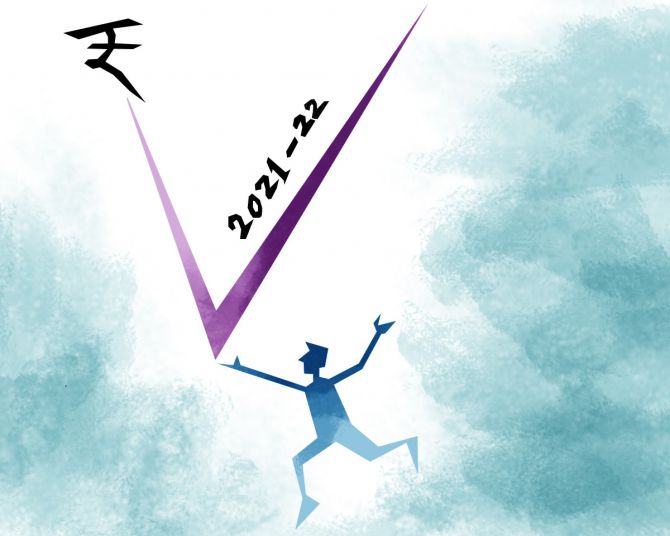 | « Back to article | Print this article |
After contracting for two quarters in a row, the Indian economy entered the positive territory with a growth of 0.4 per cent in the October-December quarter, mainly due to good performance by farm, services and construction sectors, official data showed on Friday.

Trade and hotel industry registered a contraction of 7.7 per cent during the third quarter this fiscal, as the sectors continued to suffer on account of coronavirus pandemic.
According to the data released by the National Statistical Office (NSO), the farm sector recorded a growth of 3.9 per cent, and the manufacturing sector output grew by 1.6 per cent in the quarter under review.
The construction sector advanced by 6.2 per cent, while electricity, gas, water supply and other utility services clocked a 7.3 per cent growth.
The NSO said, "GDP at Constant (2011-12) Prices in Q3 of 2020-21 is estimated at Rs 36.22 lakh crore, as against Rs 36.08 lakh crore in Q3 of 2019-20, showing a growth of 0.4 per cent".
The gross domestic product (GDP) had expanded by 3.3 per cent in the corresponding period of 2019-20.
In its second advance estimates of national accounts, the NSO has projected 8 per cent contraction in 2020-21, showing the pandemic impact.
In its first advance estimates released in January, it had projected a contraction of 7.7 per cent for the current fiscal as against a growth of four per cent in 2019-20.
"Real GDP or Gross Domestic Product (GDP) at Constant (2011-12) Prices in the year 2020-21 is estimated to attain a level of Rs 134.09 lakh crore, as against the First Revised Estimate of GDP for the year 2019-20 of Rs 145.69 lakh crore, released on 29th January 2021.
“The growth in GDP during 2020-21 is estimated at (-) 8.0 per cent as compared to 4.0 per cent in 2019-20," it stated.

The economy had shrunk by an unprecedented 24.4 per cent in the first quarter this fiscal following the coronavirus pandemic and resultant lockdowns.
In the second quarter, the GDP declined 7.3 per cent amid a perk up in economic activities after the easing of the lockdown.
The first and second-quarter GDP growth figures are revised from (-) 24.9 per cent and (-) 7.5 per cent provisional estimates, respectively, released in November 2020.
The per capita income in real terms (at 2011-12 prices) during 2020-21 is estimated to attain a level of Rs 85,929 as compared to Rs 94,566 in 2019-20 -- showing a contraction of 9.1 per cent in 2019-20 as against 2.5 per cent growth in the previous fiscal, it stated.
The per capita income at current prices during 2020-21 is estimated to be at Rs 1,27,768, a decline of 4.8 per cent as compared to Rs 1,34,186 during 2019-20.
"The measures taken by the government to contain the spread of the COVID-19 pandemic have had an impact on the economic activities as well as on the data collection mechanisms.
"The data challenges in the case of other underlying macro-economic indicators like IIP (industrial production) and CPI (retail inflation), used in the estimation of National Accounts aggregates and specific measures, if any, taken by the government in the following months with a view to address the pandemic led economic situation will have implications on the subsequent revision of these estimates," the NSO said.
Estimates are, therefore, likely to undergo sharp revisions for the aforesaid causes in due course, as per the release calendar.
Users should take this into consideration when interpreting the figures, it added.
The 0.4 per cent growth in the December quarter shows that the economy has returned to pre-pandemic times and reflects a further strengthening of V-shaped recovery, the finance ministry said on Friday.
"Real GDP growth of 0.4 per cent in Q3 of 2020-21 has returned the economy to the pre-pandemic times of positive growth rates. It is also a reflection of a further strengthening of V-shaped recovery that began in Q2 of 2020-21 after a large GDP contraction in Q1 followed one of the most stringent lockdowns imposed by Government relative to other countries," the ministry said in a statement.
"With a growth re-emerging in both GDP and GVA in Q3 FY2021, the pandemic-induced technical recession in India has ended, in line with our expectations," Icra principal economist Aditi Nayar said.
The NSO has pegged the pace of growth in Q3 FY2021 at 0.4 per cent for GDP, and a higher 1.0 per cent for the GVA, whereas Icra had projected both at 0.7 per cent, she added.
"The YoY (year-on-year) performance of the components of GDP indicates a welcome growth of 2.6 per cent in gross fixed capital formation, juxtaposed with mild de-growth of 1.1 per cent in government consumption expenditure and 2.4 per cent in private consumption expenditure," Nayar said.
Recouping of GDP to the positive territory by posting a growth of 0.4 per cent in the third quarter is a promising sign, as it portends the end of the pandemic-induced recessionary phase seen in the first half of the year, CII director general Chandrajit Banerjee said.
The growth stimuli available from the Union Budget and the additional measures, including the PLI will lead to a sturdy growth path over the recovery horizon, he added.
"The real push will come in the Q4 (January-March) 2021 because lockdowns on many sectors, particularly hospitality and travel eased substantially during this quarter.
"It is hoped that it remains that way, given the uptick in Covid19 cases in some pockets and in some states.
“Important to note that the states coming under uptick constitute a large part of industrial activity, and that is important for Q4 and the next financial year," Deloitte India partner Sanjay Kumar said.
China's economy grew by 6.5 per cent in October-December 2020, faster than the 4.9 per cent growth in July-September 2020.